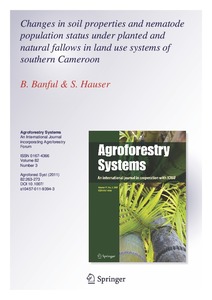| dc.contributor.author | Banful, B. |
| dc.contributor.author | Hauser, S. |
| dc.date.accessioned | 2019-12-04T11:09:20Z |
| dc.date.available | 2019-12-04T11:09:20Z |
| dc.date.issued | 2011-07 |
| dc.identifier.citation | Banful, B. & Hauser, S. (2011). Changes in soil properties and nematode population status under planted and natural fallows in land use systems of southern Cameroon. Agroforestry Systems, 82(3), 263-273. |
| dc.identifier.issn | 0167-4366 |
| dc.identifier.uri | https://hdl.handle.net/20.500.12478/2025 |
| dc.description | Published online: 13 April 2011 |
| dc.description.abstract | Changes in soil properties and nematode population status under Flemingia macrophylla [(Willd.) Merrill], Pueraria phaseoloides (Roxb.) Benth, and natural bush fallows were assessed in three villages in southern Cameroon. In each village, experiments were set up in a 4–5 year-old bush fallow dominated by Chromolaena odorata (L.) R. M. King and H. Rob and a more than 20 year-old secondary forest. Total aboveground biomass production of P. phaseoloides was 7.45 Mg ha−1, 4.2 times higher than F. macrophylla (1.78 Mg ha−1; P < 0.05). In two years (24 MAP), the soil bulk density under P. phaseoloides, F.macrophylla and the natural regrowth in both bush and forest land use systems decreased (P < 0.05). Within the same period, there was a general improvement in aggregate stability. The particle size distribution changed over 3 years (36 MAP), such that at 0–10 cm depth, the percent sand content had reduced whiles the percent clay content had increased under all the fallow systems in both bush and forest land use systems (LUSs). Soil N also increased significantly (P < 0.05) after cropping under all the fallow systems in both LUS. In contrast, soil organic carbon decreased, but the extent was lower under P. phaseoloides and F. macrophylla compared to the natural regrowth. Soil P also decreased after cropping under all the fallow systems in both LUS whereas decrease in Mg was only observed under P. phaseoloides. F. macrophylla had Mg content after cropping similar to the initial in both LUS. Soil contents of K and Ca were not significantly different over time under all the fallow systems. Comparing the initial Helicotylenchus multicinctus population to that at 12 MAP, both P. phaseoloides and F. macrophylla reduced density of H. multicinctus (P < 0.05). However, when the initial population density was compared to that at 24 MAP only under P. phaseoloides was the reduction maintained. The study concluded that the general improvement in the soil physical properties, impacted positively on the N and organic carbon contents which were sustained to a larger extent under the planted fallows than the natural regrowth. Furthermore, P. phaseoloides could be used as one component for the biological control of Helicotylenchus multicinctus, a phytopathogenic nematode. |
| dc.format.extent | 263-273 |
| dc.language.iso | en |
| dc.subject | Soil Properties |
| dc.subject | Nematode |
| dc.subject | Soil Fertility |
| dc.subject | Land Use Systems |
| dc.subject | Fallows Systems |
| dc.title | Changes in soil properties and nematode population status under planted and natural fallows in land use systems of southern Cameroon |
| dc.type | Journal Article |
| dc.description.version | Peer Review |
| cg.contributor.affiliation | Kwame Nkrumah University of Science and Technology |
| cg.contributor.affiliation | International Institute of Tropical Agriculture |
| cg.coverage.region | Africa |
| cg.coverage.region | Central Africa |
| cg.coverage.country | Cameroon |
| cg.isijournal | ISI Journal |
| cg.authorship.types | CGIAR and developing country institute |
| cg.iitasubject | Land Use |
| cg.iitasubject | Soil Fertility |
| cg.journal | Agroforestry Systems |
| cg.howpublished | Formally Published |
| cg.accessibilitystatus | Limited Access |
| local.dspaceid | 85828 |
| cg.targetaudience | Scientists |
| cg.identifier.doi | http://dx.doi.org/10.1007/s10457-011-9394-3 |

